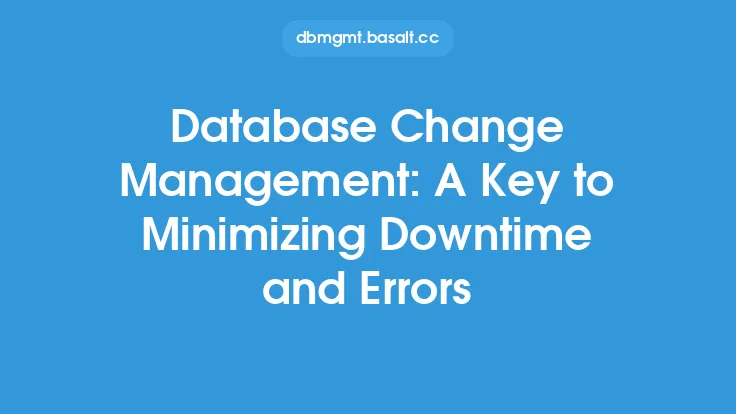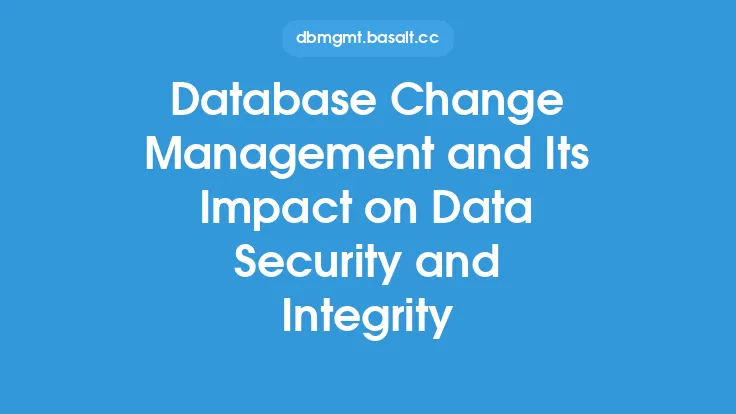Database refactoring and restructuring are essential processes in database administration that involve modifying the existing database structure to improve its performance, scalability, and maintainability. However, these processes can be complex and may involve significant changes to the database schema, which can have a ripple effect on the entire application. Therefore, it is crucial to have a well-planned change management process in place to ensure that the changes are implemented smoothly and with minimal disruption to the business.
Introduction to Change Management for Database Refactoring and Restructuring
Change management for database refactoring and restructuring involves a set of processes and procedures that help to plan, implement, and monitor changes to the database structure. The goal of change management is to ensure that the changes are made in a controlled and predictable manner, with minimal risk to the business. This involves identifying the need for change, assessing the impact of the change, developing a plan for implementing the change, and monitoring the effects of the change.
Key Principles of Change Management for Database Refactoring and Restructuring
There are several key principles that should guide the change management process for database refactoring and restructuring. These include:
- Minimal disruption: The goal of change management is to minimize disruption to the business. This means that changes should be made in a way that does not affect the normal operation of the application.
- Controlled change: Changes should be made in a controlled and predictable manner, with a clear understanding of the potential risks and benefits.
- Reversibility: Changes should be reversible, so that if something goes wrong, it is possible to roll back to the previous state.
- Testing and validation: Changes should be thoroughly tested and validated before they are implemented in production.
- Communication: Changes should be clearly communicated to all stakeholders, including developers, testers, and business users.
Steps Involved in Change Management for Database Refactoring and Restructuring
The change management process for database refactoring and restructuring involves several steps, including:
- Identify the need for change: The first step is to identify the need for change. This may involve analyzing the current database structure and identifying areas for improvement.
- Assess the impact of the change: Once the need for change has been identified, the next step is to assess the impact of the change. This involves analyzing the potential risks and benefits of the change, as well as the potential impact on the business.
- Develop a plan for implementing the change: The next step is to develop a plan for implementing the change. This involves identifying the resources required, developing a timeline, and identifying the potential risks and mitigants.
- Implement the change: Once the plan has been developed, the next step is to implement the change. This involves making the necessary changes to the database structure, as well as updating any affected applications or code.
- Test and validate the change: After the change has been implemented, the next step is to test and validate the change. This involves verifying that the change has been successfully implemented and that it has not introduced any new errors or issues.
- Monitor the effects of the change: The final step is to monitor the effects of the change. This involves tracking the performance of the database and the application, as well as identifying any potential issues or problems.
Tools and Techniques for Change Management
There are several tools and techniques that can be used to support the change management process for database refactoring and restructuring. These include:
- Version control systems: Version control systems, such as Git or Subversion, can be used to track changes to the database structure and to manage different versions of the database.
- Change management software: Change management software, such as ServiceNow or JIRA, can be used to track and manage changes to the database, as well as to automate the change management process.
- Database modeling tools: Database modeling tools, such as Entity-Relationship diagrams or data flow diagrams, can be used to model the database structure and to identify potential areas for improvement.
- Testing and validation tools: Testing and validation tools, such as unit testing frameworks or integration testing tools, can be used to test and validate changes to the database.
Best Practices for Change Management
There are several best practices that should be followed when implementing change management for database refactoring and restructuring. These include:
- Develop a clear change management process: The first best practice is to develop a clear change management process that outlines the steps involved in making changes to the database.
- Communicate changes clearly: The next best practice is to communicate changes clearly to all stakeholders, including developers, testers, and business users.
- Test and validate changes thoroughly: The next best practice is to test and validate changes thoroughly before they are implemented in production.
- Monitor the effects of changes: The final best practice is to monitor the effects of changes and to identify any potential issues or problems.
Common Challenges and Pitfalls
There are several common challenges and pitfalls that can occur when implementing change management for database refactoring and restructuring. These include:
- Insufficient testing and validation: One common challenge is insufficient testing and validation, which can lead to errors or issues being introduced into the production environment.
- Poor communication: Another common challenge is poor communication, which can lead to misunderstandings or miscommunication among stakeholders.
- Inadequate planning: Inadequate planning is another common challenge, which can lead to changes being made without a clear understanding of the potential risks and benefits.
- Inadequate resources: Inadequate resources, such as insufficient personnel or equipment, can also be a challenge when implementing change management for database refactoring and restructuring.
Conclusion
In conclusion, change management for database refactoring and restructuring is a critical process that involves planning, implementing, and monitoring changes to the database structure. By following the key principles of change management, including minimal disruption, controlled change, reversibility, testing and validation, and communication, organizations can ensure that changes are made in a controlled and predictable manner, with minimal risk to the business. By using tools and techniques, such as version control systems, change management software, database modeling tools, and testing and validation tools, organizations can support the change management process and ensure that changes are made efficiently and effectively. By following best practices, such as developing a clear change management process, communicating changes clearly, testing and validating changes thoroughly, and monitoring the effects of changes, organizations can minimize the risk of errors or issues and ensure that changes are made successfully.





